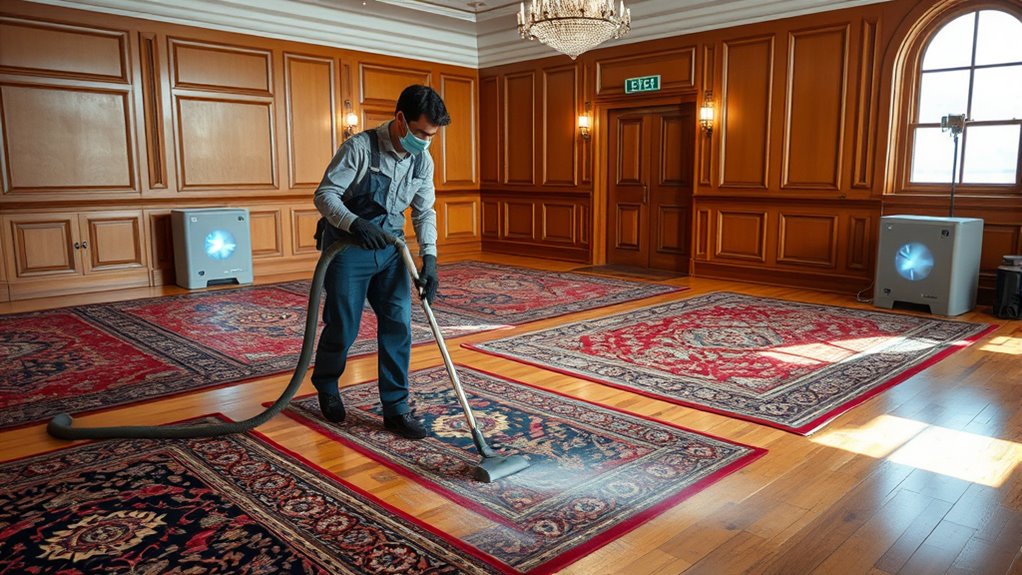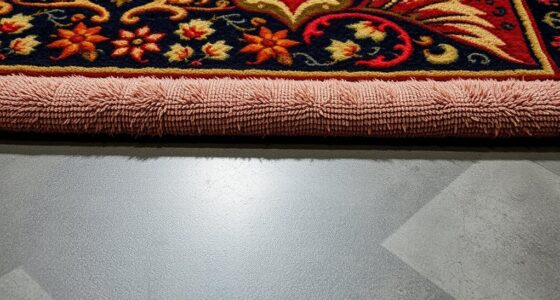To control dust in rug-filled rooms, vacuum regularly with a HEPA filter to trap tiny particles, and use microfiber cloths for dusting. Maintain a consistent cleaning schedule, keep humidity levels between 40-50%, and improve ventilation to disperse dust. Use air purifiers and seal vents during cleaning. Place doormats and enforce shoe removal to prevent tracking in dust. Implementing these strategies can greatly improve air quality—keep exploring for more effective tips.
Key Takeaways
- Regularly vacuum with HEPA filters and clean rugs frequently to reduce dust accumulation in rug-filled rooms.
- Use air purifiers and control indoor humidity between 40-50% to minimize airborne dust particles.
- Choose and treat rugs with dust-resistant materials and coatings for long-lasting dust control.
- Implement entryway mats and shoe removal policies to prevent dirt and dust from entering the room.
- Maintain proper cleaning routines, including dusting with damp cloths and sealing vents during cleaning.
Regular Vacuuming Techniques for Dust Reduction
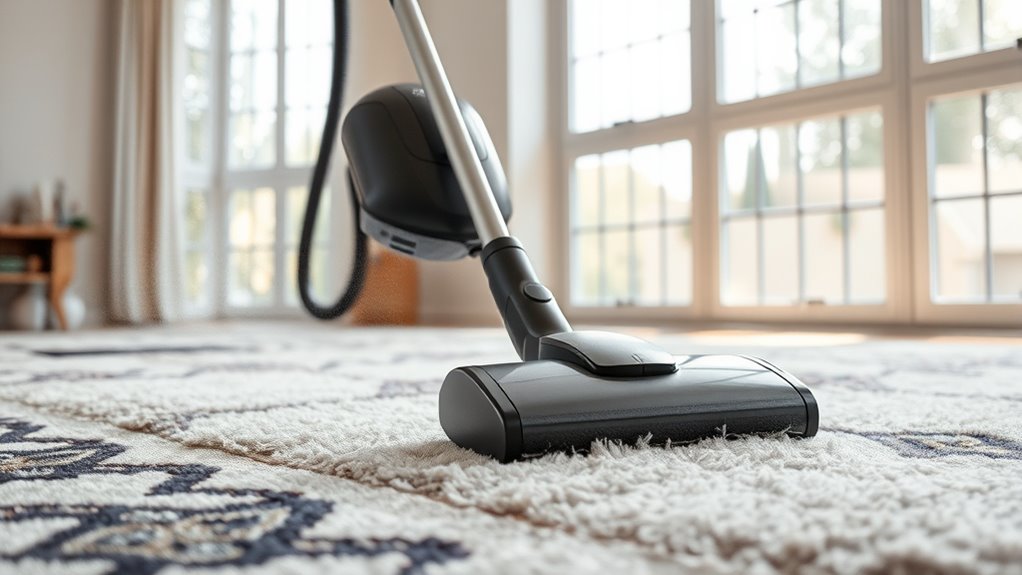
Regular vacuuming is one of the most effective ways to reduce dust buildup in your home. When you vacuum regularly, you improve air filtration by removing dust, allergens, and debris trapped in your carpets. Using a vacuum with a HEPA filter ensures that tiny particles don’t get recirculated into the air. Carpet fiber analysis can help you understand how deeply dust settles into different fibers, guiding you on how often to vacuum specific areas. Focus on slow, overlapping passes to loosen dust effectively, especially in high-traffic zones. Don’t forget to empty the vacuum bag or canister frequently to maintain suction power. Consistent vacuuming not only minimizes dust but also prolongs your carpet’s life, creating a healthier living environment.
Choosing the Right Vacuum Cleaner and Attachments
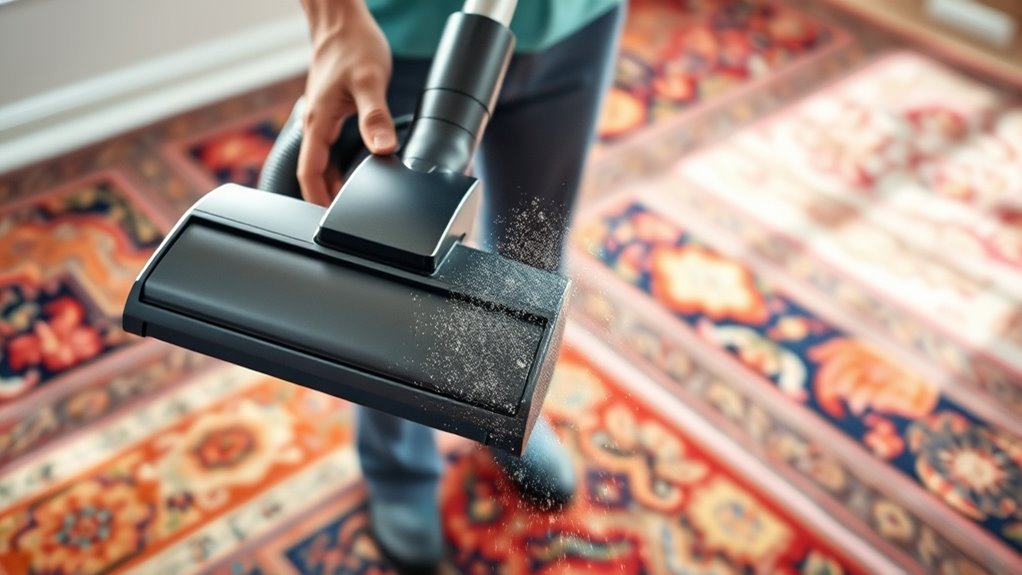
Selecting the right vacuum cleaner and attachments is essential for effective dust control, especially if you want to target dust in different areas of your home. An ergonomic vacuum design reduces fatigue, making cleaning easier and more thorough. Look for models with easy-to-maintain vacuum filters, which improve dust capture and air quality. Attachments like crevice tools and upholstery brushes help reach tight spots and delicate surfaces. Here’s a quick comparison:
| Feature | Benefits | Best Use |
|---|---|---|
| HEPA Filter | Captures fine dust and allergens | Dust-prone rooms |
| Ergonomic Design | Reduces strain during cleaning | Extended vacuuming sessions |
| Versatile Attachments | Multi-surface cleaning | Rugs, furniture, corners |
| Easy Filter Maintenance | Saves time, maintains suction | Regular dust control routines |
Choosing a vacuum with these features ensures ideal dust removal and easy maintenance.
Implementing a Consistent Cleaning Schedule

Creating a consistent cleaning schedule helps keep dust under control and reduces health risks. You should set regular cleaning times and stick to them, so dust doesn’t accumulate. Using proper dusting techniques guarantees surfaces stay cleaner longer and dust is effectively removed. Incorporating dust control measures such as using high-efficiency particulate air (HEPA) filters can further improve air quality in dust‑filled rooms.
Regular Cleaning Frequency
Establishing a consistent cleaning schedule is essential for maintaining effective dust control. By cleaning rugs regularly, you reduce dust buildup and limit dust mite proliferation, which is key for dust mite prevention. Aim to vacuum high-traffic areas at least twice a week and deep clean rugs every one to two weeks. This frequency helps minimize allergens that can trigger allergies or asthma. High-quality projectors with proper maintenance can also contribute to better air quality by reducing dust accumulation on sensitive components. Consistency ensures dust and dirt don’t accumulate, making it easier to manage indoor air quality. Don’t forget to empty vacuum bags or canisters frequently to prevent dust from escaping back into the room. A steady cleaning routine not only keeps your rugs looking fresh but also considerably contributes to allergen reduction, creating a healthier environment for everyone.
Proper Dusting Techniques
Implementing a consistent dusting routine is essential for effective dust control. To do this, use the right dusting cloths—preferably microfiber—that trap dust instead of spreading it around. Always dust in a top-to-bottom order to prevent recontamination of lower surfaces. Adjust your dusting frequency based on how quickly dust accumulates, but aim to dust at least once a week in rug-filled rooms. When dusting, avoid harsh chemicals; instead, opt for dry or slightly damp cloths to lift dust efficiently. Be thorough, paying attention to corners, vents, and under furniture. Regularly cleaning your dusting cloths ensures they remain effective. Monitoring credit card security measures can help protect payment data from cyber threats. By maintaining a proper dusting technique and sticking to a schedule, you’ll notably reduce dust buildup and improve air quality.
Using Air Purifiers to Improve Indoor Air Quality
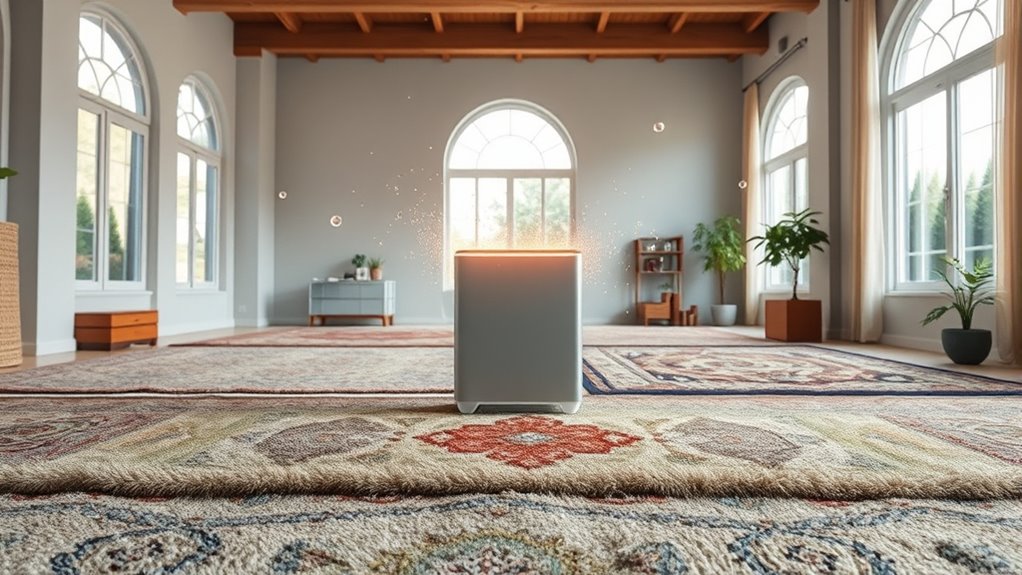
Air purifiers can considerably improve indoor air quality by removing dust, allergens, and pollutants from the air you breathe. To maximize their effectiveness, you need to carefully consider air purifier selection, choosing models with high-efficiency HEPA filters suited for your room size. Proper filter replacement schedules are essential; check manufacturer recommendations and replace filters regularly to maintain peak performance. Keep in mind that a well-maintained purifier captures more dust and allergens, reducing airborne particles that can aggravate allergies or asthma. Position the air purifier in central locations or near dust-prone areas for better circulation. By selecting the right unit and adhering to filter replacement schedules, you’ll create a cleaner, healthier indoor environment and markedly reduce dust accumulation in your rug-filled room. Regular use of air purifiers can also help in controlling Glycolic Acid Benefits for Skin, as they reduce airborne irritants and improve overall air quality.
Managing Humidity Levels to Minimize Dust Accumulation
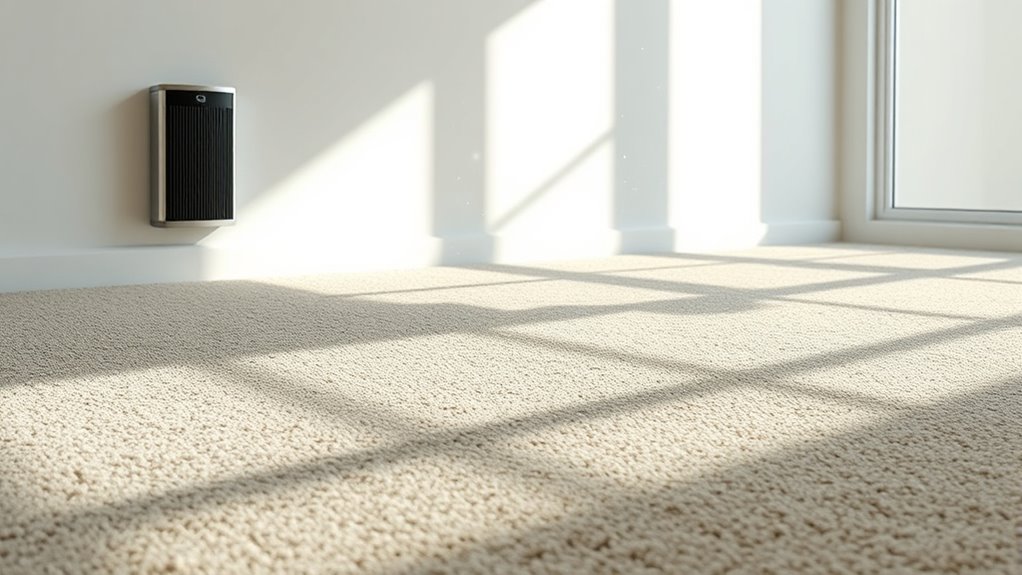
Controlling humidity levels is a key step in reducing dust buildup in your home. Proper humidity management keeps the air moisture at an ideal level, typically between 40-50%. When humidity is too low, dust particles become airborne more easily, increasing dust accumulation on surfaces. Conversely, high humidity can lead to mold growth and make dust more likely to stick to surfaces, complicating cleaning efforts. Use a hygrometer to monitor indoor humidity regularly. If levels are too low, consider using a humidifier; if too high, a dehumidifier or increased ventilation helps. Maintaining balanced humidity minimizes dust in your environment, making it easier to keep your home clean and dust-free. Consistent humidity management ensures a healthier, more comfortable living space.
Selecting Rugs and Carpets With Dust-Resistant Materials
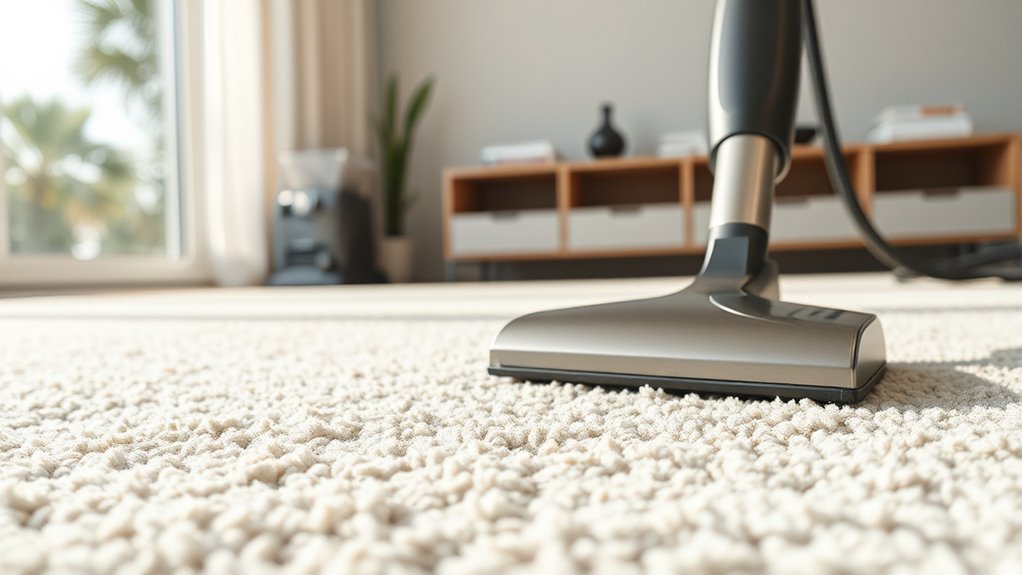
When choosing rugs and carpets, consider materials that are durable and naturally resist dust buildup. Look for weaving techniques that create tighter fibers, making it harder for dust to settle. Additionally, explore options with special treatments or coatings designed to repel dust and improve cleanliness. Incorporating easy-to-maintain materials can further simplify cleaning and reduce dust accumulation over time.
Material Durability and Dust Resistance
Choosing rugs and carpets made from durable, dust-resistant materials is essential for maintaining a cleaner environment. You should prioritize fiber resilience, which allows materials to withstand foot traffic and cleaning without breaking down or trapping dust particles. Materials with high longevity resist wear and tear, reducing the need for frequent replacements that can disturb settled dust. Look for fibers like nylon or polyester, known for their durability and dust resistance. These fibers retain their structure over time, preventing dust from settling deep within the pile. Additionally, durable materials are easier to clean, minimizing dust buildup and improving indoor air quality. Selecting high-quality, long-lasting fibers ensures your rugs stay effective for dust control, saving you time, effort, and maintaining a healthier space. Incorporating Vetted electric bike conversion kits can also reduce indoor dust by decreasing reliance on vehicles, thereby lowering dust and pollutant emissions indoors.
Weaving Techniques for Dust Control
Selecting the right weaving techniques can substantially enhance a rug or carpet’s ability to resist dust accumulation. Opt for tight, dense weaving patterns, such as specific knitting patterns, that minimize gaps where dust can settle. These tighter weaves prevent dust from penetrating deep into the fibers, making cleaning easier and prolonging the rug’s lifespan. Additionally, consider how textile dyeing methods influence fiber smoothness; certain dyeing techniques produce smoother surfaces that are less prone to trapping dust particles. By choosing weaving techniques that promote compactness and fiber finish quality, you improve dust resistance. This approach ensures your rugs stay cleaner longer, reducing maintenance effort and enhancing indoor air quality. Overall, selecting appropriate weaving methods is a key step in creating dust-resistant, easy-to-maintain rugs. Incorporating dust-resistant materials during the weaving process can further improve the effectiveness of these strategies.
Material Treatments and Coatings
Opting for rugs and carpets treated with dust-resistant materials can markedly reduce dust accumulation and simplify cleaning. Treatments and coatings, such as dust repellent finishes, create a barrier that prevents dust from embedding deeply into fibers. These finishes make it easier to vacuum and maintain cleanliness, reducing airborne dust particles. When selecting rugs and carpets, look for those specifically designed with dust-resistant treatments, as they help minimize allergens and improve indoor air quality. Applying these coatings during manufacturing ensures long-lasting effectiveness, saving you time and effort in upkeep. Keep in mind that consistent maintenance, combined with the right materials, greatly boosts dust control efforts. By choosing rugs with dust-repellent finishes, you create a healthier, cleaner environment with less frequent deep cleaning needed.
Employing Protective Measures During Rug Maintenance
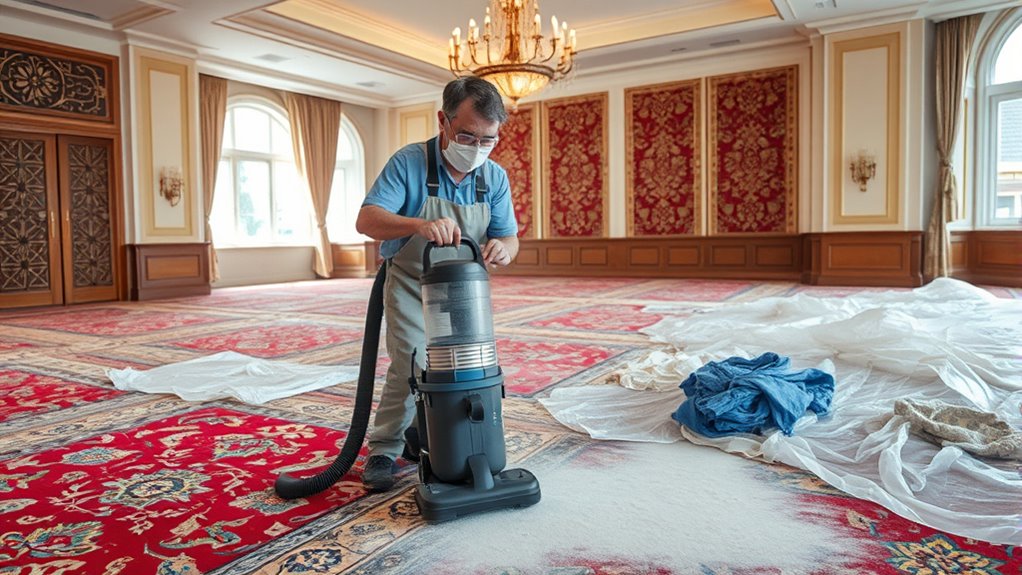
To effectively minimize dust during rug maintenance, it’s essential to employ protective measures that keep particles contained and prevent them from spreading into the environment. Use a damp cloth or microfiber mop to clean the rug surface, reducing dust mite disturbance and airborne dust. Wear a mask and gloves to prevent dust inhalation and skin contact. Seal off nearby vents and doors to limit dust dispersal. Implement allergy reduction techniques by regularly vacuuming with a HEPA filter before deep cleaning, and consider using a portable air purifier nearby during maintenance. Ensuring proper dust containment measures helps contain dust, protect your health, and minimize allergen exposure. These precautions help contain dust, protect your health, and minimize allergen exposure. Proper protective measures ensure a safer, cleaner environment while preserving indoor air quality.
Enhancing Ventilation for Better Air Circulation
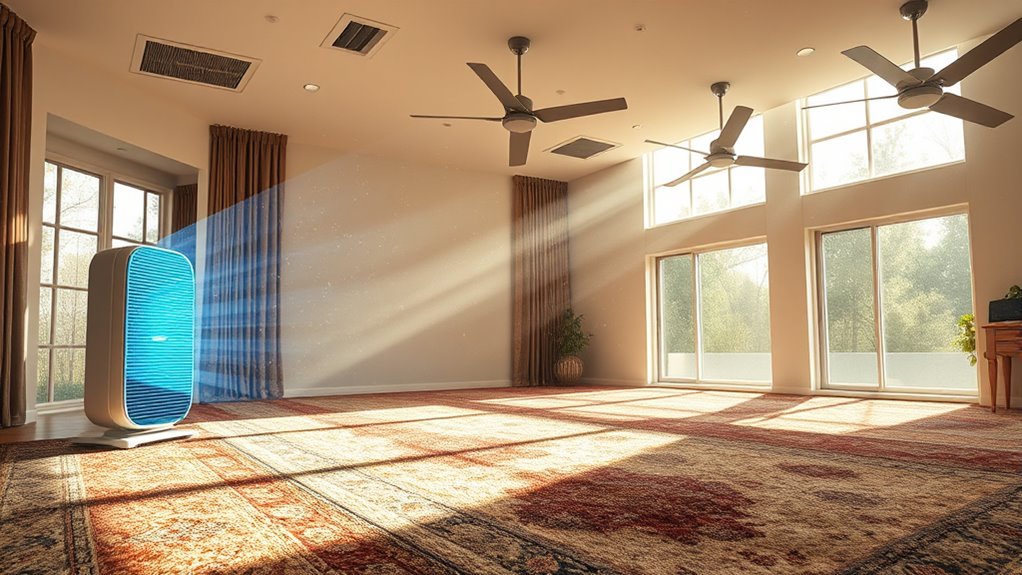
Enhancing ventilation is essential for improving air circulation during rug maintenance, as it helps disperse dust particles quickly and reduces airborne allergens. You can achieve this through airflow optimization and ventilation system upgrades. Better airflow not only clears dust faster but also creates a healthier environment, preventing dust buildup. Upgrading your ventilation system ensures consistent, effective ventilation, making rug cleaning safer and more efficient. Consider the emotional impact of a clean, dust-free space with improved air quality:
| Feeling of Freshness | Confidence in Cleanliness | Peace of Mind |
|---|---|---|
| Breathing easier | Reduced allergy symptoms | Safer environment |
| Lighter spaces | Less dust lingering | Comfort knowing you’re protected |
| Vibrant air | Enhanced well-being | Overall health boost |
Implementing proper ventilation techniques can significantly enhance air quality and comfort during cleaning.
Utilizing Doormats and Shoe Removal Policies
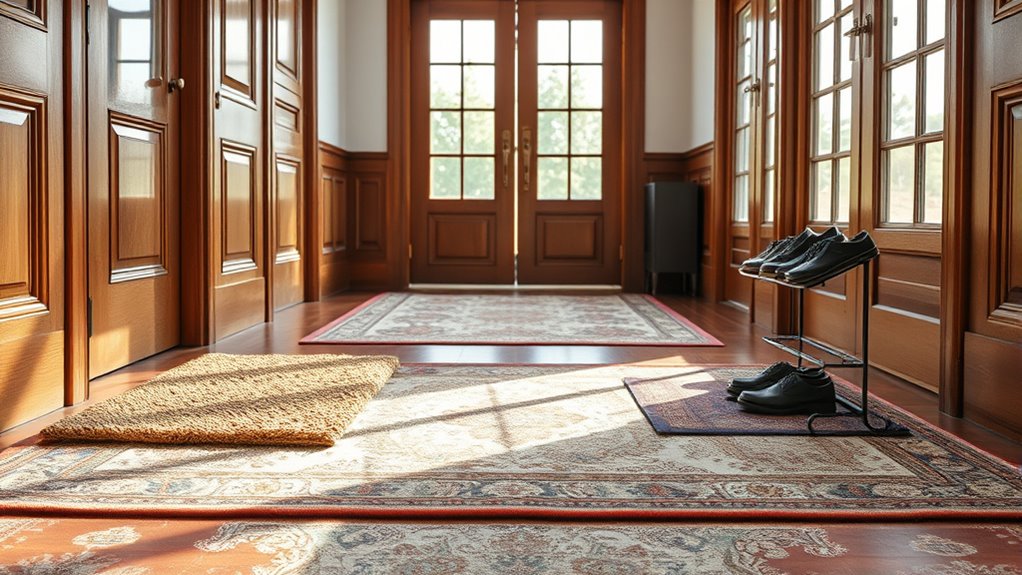
Implementing doormats and shoe removal policies is a simple yet effective way to reduce the amount of dust tracked into your home. Proper doormat placement at entryways encourages visitors and family members to wipe off entryway footwear before stepping inside. Choose durable, high-quality doormats with bristles or textured surfaces that trap dirt and dust effectively. Consider establishing a shoe removal policy, such as asking everyone to take off their shoes upon entering, to minimize dirt transfer. Providing convenient footwear storage nearby can make this easier. By actively managing entryway footwear and ensuring doormats are correctly placed, you markedly cut down on dust entering your rug-filled rooms, creating a cleaner, healthier living environment.
Incorporating Maintenance and Deep Cleaning Practices
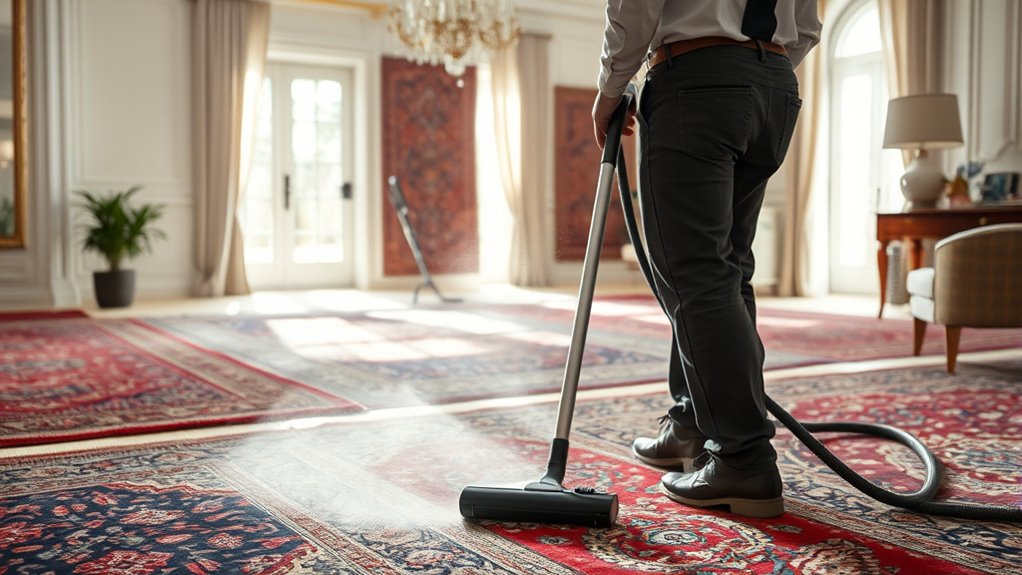
To keep dust levels low, you need to establish regular cleaning schedules that fit your space. Make sure your equipment is well-maintained so it works efficiently and doesn’t spread dust. Consistent upkeep prevents dust buildup and keeps your environment safer and cleaner.
Regular Cleaning Schedules
Establishing a regular cleaning schedule is essential for maintaining effective dust control. Consistent cleaning prevents dust buildup on surfaces and keeps dust trapping fabrics functioning *ideally*. Focus on proper area rug placement, ensuring rugs are evenly distributed and not overlapping, which can trap more dust. Regular vacuuming with a HEPA filter helps remove dust from both rugs and fabrics, reducing airborne particles. Deep cleaning your rugs periodically loosens embedded dust and dirt, preventing them from becoming sources of dust circulation. Don’t forget to wash or replace dust trapping fabrics like curtains and upholstery regularly. By sticking to a routine, you minimize dust accumulation and create a healthier environment. Consistency is key to maintaining the effectiveness of your dust control measures over time.
Equipment Maintenance Routines
Regular maintenance of your dust control equipment is essential to keep it functioning efficiently. Start with vacuum filter maintenance—regularly inspect and replace filters to prevent clogging and ensure ideal airflow. Clean filters according to manufacturer instructions, and avoid neglecting this step, as dirty filters reduce suction and increase dust dispersion. When it’s time to store equipment, follow proper equipment storage tips: keep devices in a clean, dry area away from moisture and dust, and store cords neatly to prevent damage. Perform deep cleaning routines periodically, including wiping down surfaces and checking hoses and seals for wear. Consistent maintenance not only extends your equipment’s lifespan but also guarantees maximum dust control performance, creating a safer, cleaner environment in your rug-filled room.
Frequently Asked Questions
How Do Rug Fibers Affect Dust Accumulation?
You might notice that rug fibers influence dust accumulation considerably. Higher fiber density can trap more dust, as densely woven rug material offers more surface area for particles to settle. Conversely, rugs with looser fibers allow dust to sift through and settle below the surface, reducing surface dust. Understanding how fiber density and rug material interact helps you choose the right rug to manage dust effectively, keeping your room cleaner.
What Are the Signs of Poor Dust Control in a Room?
You might notice a room feeling unusually dusty or having lingering odors, signaling poor dust control. Suspicion grows if you see visible dust on surfaces or find your allergies worsening. Pay attention to air filtration systems that aren’t functioning properly and neglecting carpet maintenance, which can lead to dust buildup. These signs warn you that your dust control measures need improvement to keep the environment clean and healthy.
Can Specific Cleaning Products Reduce Dust More Effectively?
You might wonder if specific cleaning products can reduce dust more effectively. Using products that boost vacuum efficiency helps pick up more dust with each clean. Regular cleaning frequency also plays a vital role; the more often you clean, the less dust builds up. Look for dust-specific cleaners and high-quality vacuums designed for rugs. Together, these strategies improve dust control, making your space cleaner and healthier.
How Often Should Air Purifiers Be Replaced or Serviced?
You should regularly check your air purifier for proper operation and perform routine maintenance, like replacing filters. Air purifier maintenance is vital because filter replacement frequency depends on usage and manufacturer guidelines, usually every 3 to 6 months. If you notice reduced airflow or lingering odors, it’s time for a replacement or servicing. Staying on top of maintenance ensures your device works effectively to control dust and improve indoor air quality.
Are There Eco-Friendly Options for Dust-Resistant Rugs?
Ever wonder if eco-friendly rugs can resist dust effectively? You can choose rugs made from natural fibers like wool, jute, or sisal, which naturally repel dust and allergens. Recycled materials, such as recycled PET or rubber, also offer sustainable options with dust-resistant qualities. These eco-friendly rugs reduce environmental impact while helping you maintain cleaner indoor air, making them a smart choice for health-conscious and eco-minded households alike.
Conclusion
By adopting these dust control strategies, you can significantly improve your indoor air quality and create a healthier environment. Regular vacuuming and proper humidity levels help reduce dust buildup, while air purifiers and good ventilation keep particles in check. Interestingly, some studies suggest that maintaining low humidity not only minimizes dust but also inhibits mold growth, making your efforts doubly effective. Stay consistent, and you’ll enjoy cleaner, fresher rug-filled rooms every day.
